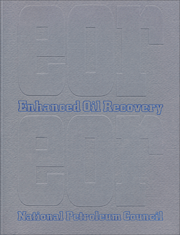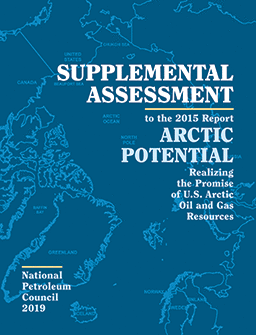
Supplemental Assessment to the 2015 Report - Arctic Potential: Realizing the Promise of U. S. Arctic Oil and Gas Resources (2019)
The Secretary of Energy, in coordination with the Secretary of the Department of the Interior, requested an update of the 2015 Arctic Potential report to prov ide views on whether the nation's regulatory environment could be enhanced to improve reliability, safety, efficiency, and environmental stewardship. The Secretary's request asked the NPC to foc us on these key areas:
- Regulatory burdens associated with U.S. Arctic Outer Continental Shelf development
- Arctic lease terms
- Arctic oil spill response technologies, including recent research conducted in Norway
- Infrastructure associated with offshore Arctic development, including onshore linkages.
The resulting Supplemental Assessment report provides the DOE and DOI with the Council's perspective on regulatory enhancements and other actions that support prudent development in the Arctic. It focuses on the four key areas in the Secretary's request with an emphasis on what is new in terms of advances in technology and experience since 20 15.
The report identifies two new findings and affirms that the 2015 findings remain valid. The new findings are:
- Improvements to current Arctic Outer Continental Shelf (OCS) regulations and their implementation could enhance safety, environmental stewardship, and public confidence.
- Lease availability, lease terms, and regulatory requirements reduce the competitiveness of Alaska OCS, compared with other opportunities worldwide .
This report also highlights nine recommendations to address both the new and prior findings.
The 2019 NPC Supplemental Assessment report is available for viewing and downloading at no charge on the NPC website (www.npc.org), along with the original 2015 report and materials.
(104 pages)
Click here to view/download a PDF of the printed report (low resolution - 7.3 MB)
Click here to download ePUB* version of the Supplemental Assessment volume (15 MB)
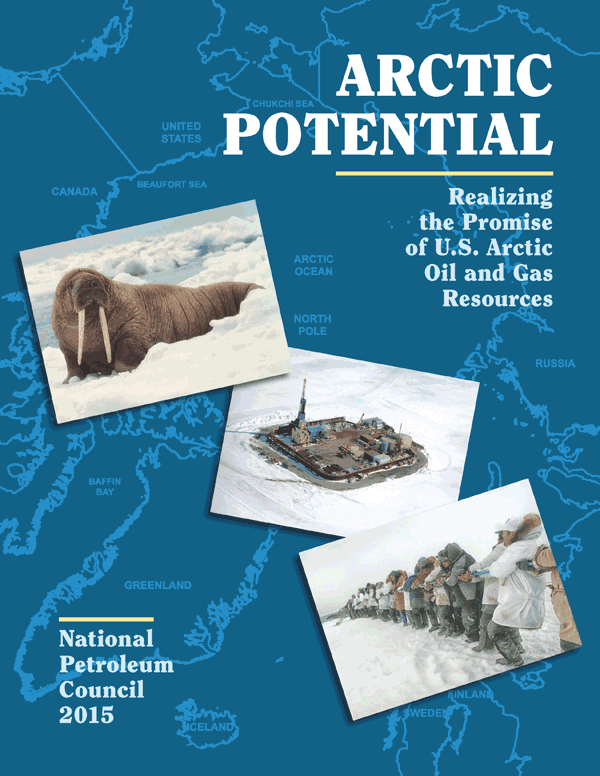
Arctic Potential: Realizing the Promise of U.S. Arctic Oil and Gas Resources (2015)
Click here to visit Arctic Potential report website
This report was prepared in response to Secretary of Energy Ernest J. Moniz’s request and provides a comprehensive study that considers research and technology opportunities to enable prudent development of U.S. Arctic offshore oil and natural gas resources. Today, there is both increasing interest in the Arctic for economic opportunit y, and concern about the future of the culture of the Arctic peoples and the environment in the face of changing climate and increased human activity. Other nations, such as Russia and China, a re moving forward with Arctic economic development. Facilitating exploration and development in the U.S. Arctic would enhance national, economic, and energy security, benefit the people of the north and the U.S. as a whole, and position the U.S. to exercise global leadership. Despite these benefits, there are diverse views on how to balance this opportunity with environmental steward ship. The National Petroleum Council considered these diverse views in generating the report Arctic Potential: Realizing the Promise of U.S. Arctic Oil and Gas Resources.
The report assessments were conducted around two key themes:
- Prudent Development in the Arctic. This theme provides context on Arctic development experience, resource potential, regulatory practi ces, and the ice and sea environment in general. The Prudent Development section is broad and its four chapters include discussions of global and domestic ice environments, experience, practice s, and development potential and challenges. This section also provides insight as the federal government takes on global leadership roles in the Arctic.
- Offshore Arctic Research and Technology. This theme’s analyses focus on two important areas:
- The Technology and Operations section addresses the needs for exploration and development of conventional offshore resources. This sectio n includes four chapters discussing the characterization and measurement of the ice environment; offshore Arctic exploration and development technology; logistics and infrastructure; and oil spil l prevention, control, and response.
- The Ecological and Human Environment section includes two chapters characterizing these two areas of significant importance in the Arctic.
The NPC study assessments led to seven key findings addressing:
- Estimates of Arctic oil and gas resources
- Challenges posed by the Arctic environment
- History of Arctic oil and gas operations and technology advances
- Capability of developing U.S. Arctic oil and gas resources using existing technology
- Challenges to economic viability of U.S. Arctic oil and gas development
- Role of securing public confidence in realizing the promise of U.S. Arctic oil and gas resources
- Technology and regulatory advancements to reduce the potential for and consequences of a spill.
Based on these findings, the report proposes recommendations, grouped into three broad themes:
- Environmental Stewardship
- Oil spill prevention and source control
- Oil spill response in ice
- Increasing knowledge of Arctic ecology and human environment
- Economic Viability
- Technologies to safely extend the drilling season
- Lease terms appropriate to Arctic conditions
- Effective policies and regulations
- Enabling infrastructure
- Government Leadership and Policy Coordination
- Domestic leadership and policy coordination
- U.S. chairmanship of the Arctic Council.
The NPC is making the study results and many of the documents developed by the study groups available to all interested parties as follows:
- Executive Summary Volume: Report Transmittal Letter, Full Report Outline, Preface, and Executive Summary via printed report and the NPC website
- Full Report Volume: Report Transmittal Letter, Table of Contents, Preface, Executive Summary, 10 Chapters, and Appendices via printed re port and the NPC website
- Topic Papers via the NPC website: These formed the basis for the Technology and Operations section’s analyses that led to the deve lopment of the summary results presented in the report’s Executive Summary and Chapters. The Council believes that these materials will be of interest to the readers of the report and wil l help them better understand the results.
- Materials related to March 27, 2015, meeting at which the NPC reviewed and approved this report via the NPC website:
- Report Video (5 minutes)
- Study Slide Presentation by NPC Committee on Arctic Research
- Webcast Archive of the Meeting.
EXECUTIVE SUMMARY VOLUME - includes Preface and Executive Summary (84 pages)
Purchase Printed Version:
Click here to view/download PDF version of the Executive Summary volume (21 MB)
Click here to view/download a low-resolution PDF version of the Executive Summary volume (4.5 MB)
Click here to download ePUB* version of the Executive Summary volume (15 MB)
FULL REPORT VOLUME - includes Preface, Executive Summary, Chapters, and Appendices (588 pages)
Purchase Printed Version:
FULL REPORT VOLUME BY SECTION - PDF
Click here to view/download PDF version of the Executive Summary (21 MB)
Click here to view/download a low-resolution PDF version of the Executive Summary (4.5 MB)
Click here to download PDF version of Part One - Prudent Development (Overview, Chapters 1-4)
(47.8 MB)
Click here to view/download a low-resolution PDF version of Part One - Prudent Development
(Overview, Chapters 1-4) (7.4 MB)
Click here to view/download PDF version of Part Two - Technology and Operations (Overview, Chapters 5-8) (51.4 MB)
Click here to view/download a low-resolution PDF version of Part Two - Technology and Operations (Overview, Chapte rs 5-8) (8.8 MB)
Click here to view/download PDF version of Part Three - Ecological and Human Environment
(Overview, Chapters 9-10) (14.4 MB)
Click here to view/download a low-resolution PDF version of Part Three - Ecological and Human Environment (Overvie w, Chapters 9-10) (3.7 MB)
Click here to view/download PDF version of Appendices A-D and Acronyms and Abbreviations (5.6 MB)
Click here to view/download a low-resolution PDF version of Appendices A-D and Acronyms and Abbreviation (< 1 MB)
FULL REPORT VOLUME BY SECTION - ePUB*
Click here to view/download ePUB version of the Full Report - includes Preface, Executive Summary, Chapters, and Appendices (243 MB)
Click here to view/download ePUB version of the Preface and Executive Summary (29.7 MB)
Click here to download ePUB version of Part On
e - Prudent Development (Overview, Chapters 1-4)
(60.1 MB)
Click here to view/download ePUB version of Part Two - Technology and Operations (Ove rview, Chapters 5-8) (117.5 MB)
Click here to view/download ePUB version of P
art Three - Ecological and Human Environment
(Overview, Chapters 9-10) (36.5 MB)
Click here to view/download ePUB version of Appendices A-D and Acronyms and Abbreviatio ns (3.5 MB)
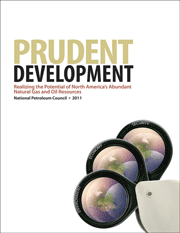
Prudent Development: Realizing the Potential of North America’ s Abundant Natural Gas and Oil Resources (2011)
Click here for downloading/purchasing options
Archive of September 15, 2011 meeting and press conference webcast
This report was prepared in response to Secretary Chu’s request and provides a comprehensive reassessment of the character and potential of North American natural gas and oil resources, and the contribution that natural gas can make in a transition to a lower carbon energy mix while achieving objectives of environmental protection, economic growth, and energy security. The report assesses resource and supply, environmental and operational, technology, demand, infrastructure, emissions, and macroeconomic considerations, and presents findings in four integrated conclusions:
- Natural gas is an abundant resource.
- Surprisingly, oil resources are also abundant.
- America needs gas and oil.
- These benefits depend upon prudent development.
Based on these findings, the report proposes five core strategies for governments and companies to assist markets in meeting the energy c hallenges of 2035 and beyond:
- Support prudent development.
- Better reflect environmental impacts in markets and choices.
- Enhance the efficient use of energy.
- Enhance the regulation of markets.
- Support needed talent and know-how.
The NPC is making the study results and many of the documents developed by the study groups available to all interested parties as follow s:
- Summary Volume: Report Transmittal Letter, Preface, and Executive Summary via printed report and the NPC website
- Full Report Volume: Report Transmittal Letter, Preface, Executive Summary, five Chapters, and Appendices via printed report and the NPC website
- Topic and White Papers, and other supporting materials via the NPC website. These formed the basis for the analyses that led to the development of
the summary results presented in the report’s Executive Summary and Chapters. The Council believes that these materials will be of interest to the readers of the report and will help them b
etter understand the results.
SUMMARY VOLUME - includes Preface and Executive Summary (72 pages)
Printed Version:
No longer available for purchase.
Download .pdf version: Click here to download.
Download .epub version:
Click here to download Preface.*
Click here to download Executive Summary.*
FULL REPORT VOLUME - includes Preface, Executive Summary, Chapters, and Appendices (480 pages)
Click here to purchase printed version:
Download .pdf version:
Click
here to download Summary sections (4.8 mb)
(contains the report transmittal letter, table of contents, preface, and executive summary of the study's findings and recommendations)
Click here to download Chapter One: Resource and Sup ply (7.1 mb)
Click here to download Chapter Two: Operations and E nvironment (11.3 mb)
Click here to download Chapter Three: Demand (4.4 mb)
Click here to download Chapter Four: Carbon and Other End-use Emissions (1.3 mb)
Click here to download Chapter Five: Macroeconomics ( 1.7 mb)
Click here to download Appendix A: Request Letters, Descr iption of the NPC, and NPC Membership Roster (6.7 mb)
Click here to download Appendix B: Study Group Rosters (.5 mb)
Click here to download Appendix C: Additional Materials Av ailable Electronically (.6 mb)
Click here to download Abbre viations and Acronyms, Conversion Factors (.3 mb)
Click here to download Figure ES-11: Natural G as & Oil Well Regulation chart (11" x 17")
Click here to download Figure 2 -9: Evolution of Technology Timeline Graphic (two-page version, 11" x 17")
Download .epub version*:
Click here to download Preface*
Click here to download Executive Summary.*
Click here to download Chapter One: Resource and Supply*
Click here to download Chapter Two: Operations and Environment*
Click here to download Chapter Three: Demand*
Click here to download Chapter Four: Carbon and Other End-use Emissions*
Click here to download Chapter Five: Macroeconomics*
Click here to download Appendix A: Request Letters, Description of the NPC, and NPC Membe rship Roster.*
Click here to download Appendix B: Study Group Rosters*
Click here to download Appendix C: Additional Materials Available Electronically -include s abstracts on 55 Topic/White Papers developed for the study*
Topic and White Papers
These formed the basis for the analyses that led to the development of the summary results presented in the report's Executive Summary and Chapters. While the members of the NPC were not asked to approve these papers, they believe that these materials will be of interest to the readers of the report and will help them better understand the results.
Click here to download .pdf versions of Topic and White Papers.

This report is an assessment of the costs and benefits of incentives for maintaining production from the more than 500,000 marginal oil wells in the U nited States. These wells produce approximately 700 million barrels of oil equivalent per year and represent $10 billion of avoided imports each year. They contribute nearly 80,000 jobs and gener ate close to $14 billion per year in economic activity.
The report is in response to Secretary O’Leary’s request for the NPC to evaluate the costs and benefits of various actions to mainta in this production. The report presents the NPC’s recommendations for four federal income tax incentives to encourage continued operation of marginal wells, particularly in periods of low p rices. Because of the cost structure of marginal wells, the NPC also recommends that regulatory, royalty, and state tax incentives and relief are needed to reduce the impact of increasing costs.< /p>
The report describes domestic oil and gas marginal well production and the access to potential reserves that those wells provide. Physical and e conomic characteristics of such wells are examined and evaluations of marginal well contributions to the national, state, and local economies as well as to the oil and gas industries are provided . U.S. producing wells are evaluated for marginality on a before federal income tax basis. Detailed economic analyses on an after tax basis are presented for several types of marginal well credit s as well as for an improved EOR credit and an inactive well incentive. In addition, state incentives are examined and federal regulatory issues are reviewed.
(356 pages)
Click here to view/download a .pdf of the printed report (lo w resolution - 42.3 MB).
The 1984 EOR report presents estimates of the amount and timing of incremental oil that might be recovered through the application of EOR techni ques to known reservoirs in the United States. The analysis is based on a resource data base consisting of over 2,500 reservoirs with approximately 325 billion barrels of oil originally in place. Incremental ultimate recovery achievable from EOR processes, and potential producing rates during the 30-year time frame of the study are calculated for a wide range of technical and economic as sumptions (four oil prices, three minimum rate of return requirements, and two technology cases).
Three general classifications of EOR methods are considered: chemical flooding, miscible flooding, and thermal recovery. In addition, the report outlines the significant changes affecting enhanced recovery since the 1976 report was issued. The potential environmental impacts associated with EOR operations are assessed, as is the relative importance of enhanced oil recovery to the nation’s energy supply.
The report also addresses recent research efforts and the future implications for research and development programs.
(302 pages)
Click here to view/download a .pdf of the pri nted report (normal resolution - 30.6 MB).
Click here to view/download a .pdf of the printed report (low resolution - 15.8 MB).
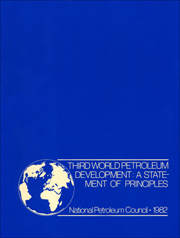
Third World Petroleum Development:
A Statement of Principles (1982)
The report analyzes the factors that affect the decisions of U.S. private petroleum companies to explore for and develop petroleum in oil-import ing developing countries (OIDCs). The report recommends measures that the OIDCs and U.S. government can take to encourage private companies to explore for and develop oil and gas. The NPC’s view of the appropriate role for certain third party public agencies, in particular The World Bank, is also discussed.
The report does not include detailed resource assessments, critique the programs of specific OIDCs, or discuss oil and gas exploration and devel opment activities of countries outside the free world.
(52 pages)
Click here to view/download a .pdf of the printed report (low resolution - 4.2 MB).
U.S. Arctic Oil and Gas (1981)
The report estimates the potential contribution to U.S. oil and gas supplies from production in currently undeveloped areas in the Arctic region s of the United States. In the report, the Arctic region is broadly defined as territory under U.S. jurisdiction north of Alaska’s Aleutian islands offshore and north of the Brooks Range on shore. The report discusses: resource assessment information; exploration, production, and transportation technology and economics; environmental, community, and regulatory considerations; and ju risdictional issues.
(326 pages)
Click here to view/download a .pdf of the print ed report (low resolution - 43.2 MB).
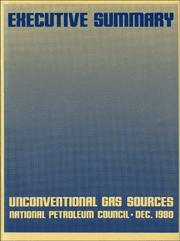
Unconventional Gas Sources (1980)
The report consists of five volumes: Volume I - Executive Summary; Volume II - Coal Seams; Volume III - Devonian Shale; Volume IV - Geopressured Br ines; Volume V - Tight Gas Reservoirs.For each gas source, reserve additions and producing rates are calculated at five gas prices, three rates of return, and at least two levels of technology. The volumes also include an overview of the resource, an analysis of the technological state of the art, an examination of constraints or uncertainties that may impede development or production, and a comparison of the NPC findings with those of other studies on the resource.
Volume I - Executive Summary
(56 pages)
Volume II - Coal Seams
(128 pages)
Volume III - Devonian Shale
(252 pages)
Volume IV - Geopressured Brines
(212 pages)
Volume V - Tight Gas Reservoirs
Part I - Resource Assessment
(492 pages)
Part II - Basin Analyses
(800 pages)
Download .pdf version:
Click here to view/download Interim Summary (5.9 MB)
Click here to view/download Volume I - Executive Summary (7 MB)
Click here to view/download Volume II - Coal Seams (16.8 MB)
Click here to view/download Volume III - Devonian Shale (45.8 MB)
Click here to view/download Volume IV - Geopressured Brines (33.8 MB)
Click here to view/download Volume V, Part 1 - T ight Gas Reservoirs (93.4 MB)
Click here to view/download Volume V, Part 2 - Tight Gas Rese rvoirs (91.1 MB)
4/4/23
.
